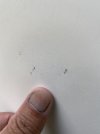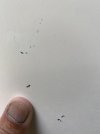I just bought a project boat that I hoped to just buff the gel coat but looks like I’m going to have to redo it from the rail down to the first body line. I hope someone has experience with this that can keep me straight. I restored a boat a while back but opted to paint with a polyurethane and it was beautiful but I really feel paint kills the value of the boat. I understand the process for filling all the scratches and gouges to get it slick but I’m interested if someone knows what grit to prep for spraying and then process for blocking and buffing. I know this is a paint forum but usually one of you guys has some experience to pass on for just about anything. If anyone cares it’s a Cape Horn 21’ offshore boat. Just solid white.
You are using an out of date browser. It may not display this or other websites correctly.
You should upgrade or use an alternative browser.
You should upgrade or use an alternative browser.
How to gel coat a boat
- Thread starter Gmills
- Start date
Jim C
Oldtimer
actually its quite the opposite. a lot of higher end yachts are all painted. people pay big money to have their boat paint instead of gel. as longs as its properly done then paint should add to the value of the boat. boat paintjobs are extremely expensive. i can tell you the last 65 viking that the service center here did had a bill of about $150k. if you still opt to use gel you need to get the gel and be sure it has wax added to it. gel that goes in a mold is slightly different than gel that is sprayed on with the good surface out. gel spray dull and super lumpy so once sprayed it needs to be all blocked out then sanded to 1000 grit then compound and polished. its a big labor intensive job.
I’ve decided to paint for sure. Ordered white epoxy and am trying to fill all the dings and scrapes in the gel coat. I was originally going to attempt to save the gel coat so I was mixing gel coat and thickening for filler. Is there some other type filler that would work better? Some type of fairing compound? It has a few gouges but mostly chips probably from fishing weighs hitting the side.
Jim if you have any more instructions I would love to hear it. This is quite different that normal bodywork. Barry said finish with 180 for epoxy. If I could do my sanding with 80 to fill lows how can I get it to 180 for primer. Not like I can use high build. Can I just guide coat and sand the original gel coat to remove 80 get scratches?
Jim C
Oldtimer
For a filler you use adtech p-17 or p-14. You can also use gel thickened with some fumed silica to make a gel patch material to repair small nicks, chips and gouges. Im not exactly aure what you are doing with 80 grit. You should not be breaking through the gel when you sand it. Just fix the chips, scuff it all with 180 and shoot epoxy. If you have large areas you need to block down to the Glass then you will need to regel those areas before epoxy. Dont just shoot epoxy and paint over glass with no gel over it or you will have big time readthrough and see the glass print in your paintjob when it heats up in the sun.
Jim I’m thickening the gel coat to fill chips and scratches but not doing very good with it. I’ve filled two rounds and attempting to sand it flat with the 180 but the stuff is harder than woodpecker lips. That why I was asking about 80 to knock down what I’m using for filler. I Have three or four spots about the size of a quarter that are bare glass where there was some type of repair. Do you think these small spots will show? I appreciate your opinion on everything and I feel pretty stupid right now. I told my son this is the last boat project. This is 3 in about a year and a half. I painted one of those that turned out beautiful but it seemed easier.
Jim C
Oldtimer
the quarter spots to raw glass will show when the glass gets hot in the sun....assuming this is in an area that is going to see direct sun. it will also depend on color. white will obviously not get as hot as something like a grey or black. those spots will need gel or polyester primer over them. it cant be paper thin either. if its a white color and it wont be facing the sun then you can prob get away with just some epoxy. for the chips, im not sure what you are thickening the gel with but you can make it into a paste. with a hard block you should be able to knock it right down with 180. you can use 80 if you want but you need to refine the scratches when your done to something like 180. after the 80 grit scribble over the area with a pencil then sand again with 180 until the 80 grit scratches are gone.
These tiny spots are some of what is killing me. I mark them with tape so I can find them after sanding and cleaning. The gel I mix pulls out if I try to spread it on thin and if I leave it thick it’s the devil to sand flat.


